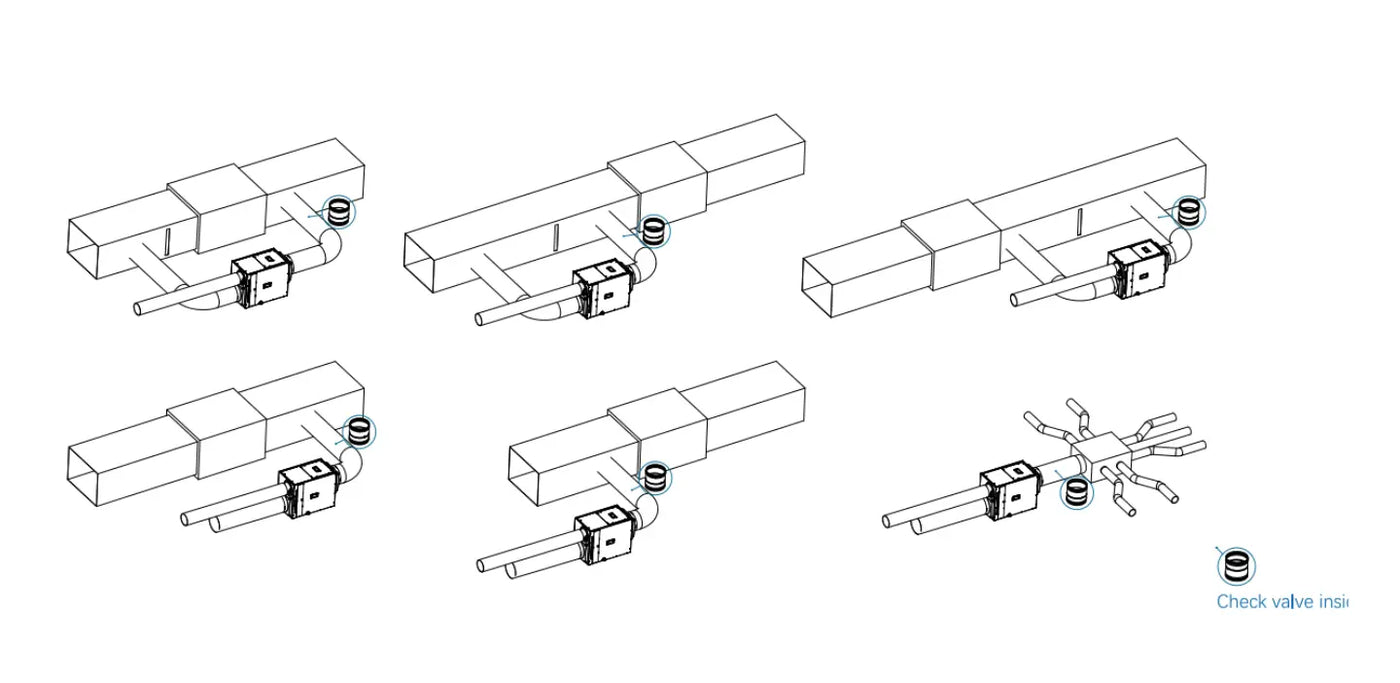Whole house dehumidifier prices exist between $1000 and $2500 for the device, along with the cost of installation from a professional. Dehumidifiers that serve basic-sized homes begin at $900 in price, yet powerful large units meant for oversized areas exceeding 2,000 square feet run from $2,000 up to more expensive levels. Professional installation fees that include connection to your HVAC system or difficult installation space, like crawl spaces or attics, will result in costs that exceed $2,500.
The initial cost of a whole house dehumidifier becomes affordable in the long run since it creates better air quality while lowering mold potential and improving HVAC performance. The installation of multi-portable units requires greater space, while whole house dehumidifiers create savings through reduced time and increased space and energy efficiency. Let’s find out how the factors impact the cost, and are dehumidifiers worth it!
Factors That Affect the Cost

The purchasing expenses of whole house dehumidifiers depend on multiple components. The cost breakdown of whole house dehumidifiers depends on a few key elements, which you can use to manage your budget more effectively.
1. Size and Capacity
The unit price depends directly on the daily pint measurement of the dehumidifier. The capacity levels of dehumidifiers need to match the size of the homestead. The price of a 90-pint house dehumidifier system setup for 2,300 sq. ft. will exceed the cost of a 50-pint unit. Selecting a suitable capacity ensures both efficient performance and extended lifetime of the dehumidifier.
2. Installation Complexity
A standalone dehumidifier setup costs less for installation than systems that need an HVAC connection. Adjusted or new ductwork installation costs will increase because labor prices rise when extra work is required. The installation costs increase when professionals need to extend mounting or install waterproofing features for spaces such as crawl spaces or attics.
3. Brand and Features
The addition of remote-control capability together with energy-saving modes, built-in pumps, and digital humidity sensors will significantly increase the unit's price. These devices provide better performance combined with ease of use, which minimizes future maintenance requirements.
4. Local Labor Rates
Installation costs vary by region. The implementation cost will be higher when you live in a location where local labor rates are elevated.
Additional Costs to Consider

You should evaluate the initial unit cost alongside all associated expenses, which will boost the overall total.
1. Installation Fees
The cost of labor for professional installation covers a range from $300 to $700 based on project difficulty. Additional expenses will occur when the system requires new ductwork or electrical system improvements.
2. Maintenance and Filter Replacements
The upkeep of whole house dehumidifiers remains simple, yet consumers need to replace or clean filters approximately every few months. The total annual expenses for filters and basic maintenance will cost $50 to $100.
3. Electrical Work
The installation process requires hard wires for systems that connect to HVAC features. The cost ranges from $100 to $300 to hire an electrician when there is no electrical outlet available next to the system.
4. Drainage Solutions
Proper drainage is necessary. A condensate pump with typical pricing between $75 and $150, together with hoses, might be necessary in case gravity drainage is impossible. The additional components prevent water leakage while ensuring complete water drainage.
5. Energy Usage
Whole house systems operate better than multiple portable units, yet they contribute to increased utility expenses. The use of energy-efficient models reduces future expenses for consumers.
How to Choose the Right Whole House Dehumidifier

Selecting the right system means that you are not spending much on the system or end up with a poor system that will not meet your needs. Here are the factors that should be considered when choosing a model:
1. Measure Your Home’s Size
To begin, determine the square footage of the room in which you are planning to apply the paint or the entire house. Then, align it with a unit appropriately suited for that area. Some models indicate their coverage area in the product descriptions, and it is helpful to look for that.
2. Know Your Humidity Levels
People living in houses in humid areas or houses with basements and crawl spaces may require larger systems. A hygrometer can assist you in estimating average humidity to select the equipment that will fulfill the demand at your home.
3. Check Unit Features
For everyday use, consider the roller’s convenience: It should have a shut-off function, digital controls, washable filters, and even a built-in pump let-out. Though these may increase the initial cost, they have the benefit of saving costs in the long term.
4. Consider Installation Type
Determine if you prefer an independent humidifier or one that is hooked up to your heating and cooling system. Therefore, you should opt for a ducted system if you do not want your equipment to be conspicuous and desire a centralized airflow system. However, with standalone models, it is easier to install and maintain them in the system.
5. Choose a Trusted Brand
Whole house dehumidifiers from reputable companies are more durable and efficient and come with better customer service. Always compare the reliability of the associated products, warranty, and customer support options available before making a purchase.
Learn More: What Size Dehumidifier For A Crawl Space
How to Save on Costs Without Compromising Quality
Actually, there are many ways to acquire an affordable whole house dehumidifier while not compromising on quality.
1. Choose the Right Size—Not the Biggest
Larger models are not always the best; in fact, choosing a small model can lead to numerous benefits. Large units also have a short cycle, which means they wear out faster and or guzzle up energy. Cherry and mahogany are good choices that can be easily maintained and come in sizes suitable for the room’s available space and humidity levels.
2. DIY Installation (When Possible)
If you are a do-it-yourself kind of person and the unit is a standalone unit, you may rig it yourself. This could save you hundreds in labor costs. For central or wired systems, it is advisable to seek the services of a professional to avoid mishaps.
3. Use Gravity Drainage
Do not require a condensate pump by installing the whole house dehumidifier where the water would naturally flow down. This reduces the cost of investing in equipment and other subsequent expenses.
4. Maintain Your System Regularly
Air filters should be cleaned, hoses examined, and blockages checked at least once a season. A well-maintained unit usually has a longer life cycle. It has a better reliability level than that of an item that has not been maintained, so it is not prone to frequent repairs or replacement.
5. Look for Rebates or Discounts
There are cases where some utility organizations or local authorities provide rebate options for whole house dehumidifiers. You can also inquire from our site or the installer about the amount you can save.
Why Whole House Dehumidifiers Are Worth the Investment
While a whole house dehumidifier is relatively more expensive than a portable dehumidifier initially, the advantages in the long run are numerous:
-
Conveniences: They control the humidity, which makes one sticky and uncomfortable.
-
Health: Low humidity inhibits mold and dust mites, and other allergens from thriving.
-
Home Protection: With moisture, it becomes possible to cause damage to the wood, paint, insulation, and floor. Dehumidifiers maintain the structural integrity of any home.
-
Energy conservation: Since a house dehumidifier system reduces the burden on your air conditioner, it is an effective way of saving money on electricity bills in the long run.
-
Ease: These systems are easy to install, and once they have been installed, they do not need much attention other than cleaning.
All in all, it has cleaner, drier air throughout the house, plus the convenience of not having to deal with multiple portable air conditioners.
Final Thoughts
A whole house dehumidifier is a worthwhile addition to the existing HVAC system for anyone living in a humid environment or experiencing high indoor humidity levels. Although the initial cost is between $1,000 and $2,500, understanding the causes of pricing will assist you in making an informed decision. From unit capacity and features to installation complexity and extra costs, it’s important to look beyond the sticker price.
So, the size must be chosen carefully, the features need to be compared, the system should be maintained properly, the air will be clean, the climate will be pleasant, and the money will be saved in the long run. For any house, especially those with basements or crawl spaces, a house dehumidifier system will provide a long-term solution to this problem.
AlorAir, as a best dehumidifier brand, provides its customers with highly effective, durable, and energy-efficient home moisture control solutions. These systems have been favored by homeowners and professionals alike for their effectiveness and durability.
Read more:
Whole Home Vs. Crawl Space Dehumidifier – Which Do You Need?












